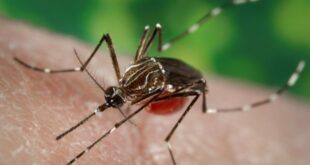Bugs are sold to greenhouses to manage other unwanted pests.

You can smell the bees before you see them.
Mixed between honey and pollen, the scent is overwhelmingly sweet as it wafts through the door in a shed placed on a rural piece of property in Amherstburg, Ont.
When the door is opened that’s when you hear them — thousands of bumblebees angry with the light and noise.
The bees are waiting to be purchased by local greenhouses that will use them for pollination.
“Pollination is how much fruit you’re going to get, so for a farmer, they’re not going to play around with their pollination,” said Meshal Mustafa, who helps run the family business, Growliv.

Mustafa’s parents, both entomologists, started the company in 2014 with a single bug.
The company now breeds 17 species of bugs, which equates to the production of hundreds of millions of insects a week. They believe it’s the largest bug breeding farm in North America with about 36,000 square feet of laboratory space and annual sales of $3.5 million.
“I am known as the bug lady among my friends for sure,” chuckled Mustafa.
Most of the insect species on the farm don’t pollinate, they’re used more as a defence mechanism — bred to eat the unwanted bugs that invade certain crops. It’s a process called biocontrol.
Predators versus pesticides
White flies, for example, can stunt the production of tomatoes but green lacewing larvae, an insect Growliv breeds, will feed on them.
Mustafa said the greenhouses usually make arrangements to buy the bugs before growing any crops.
“It’s a natural way to control pests without having to spray their crops with pesticides, this is like the first line of defence now,” said Mustafa.
On top of pesticide use potentially having harmful environmental impacts, particularly when a pesticide moves outside of the intended application site, Mustafa said pesticides can also stop working, similar to the way humans can develop a resistance to antibiotics if taken too often and for long periods of time.
“It’s a similar case for pesticides,” she said.
Essex-County biocontrol is a growing industry with a “long list of companies” starting to breed bugs, according to Roselyne Labbe, a research scientist with Agriculture and Agri-Food Canada, the department of the federal government responsible for the federal regulation of agriculture.
That means millions and millions of bugs are procreated, fed, harvested, shipped and dispersed across greenhouses in the region.
Gross? Depends on how you feel about bugs, but Labbe said it’s completely safe.
“A lot of them are natural species so they are already present anyways,” she said.
Labbe also added that once the target pest has disappeared, the predator bug often will as well because there isn’t anything to eat.
“It’s one of the sustainable options … The government absolutely sees ecosystem resilience as a key priority. We need to have very sustainable systems for pest management,” she said.

She said if the pests are left untreated greenhouses could incur large economic losses as greenhouses solve their pest issues.
Mustafa said it hasn’t always been easy getting farmers to change their growing ways but said her parents have been able to explain the benefit of insect predators over pesticides.
Attributing that to hard work, dedication and a passion for creatures that don’t always get a lot of love.
“It opened my eyes to what is right in front of me outside that I never noticed or appreciated,” she said.
ABOUT THE AUTHOR
Meg is a multi-platform reporter and host working at CBC Windsor. She previously worked as a reporter for CBC Newfoundland and Labrador and CBC Toronto. She also was a member of the CBC Olympics team for the 2020 and 2022 Olympics. Meg covers a wide range of breaking news and feature stories. Email her at meg.roberts@cbc.ca.
*****
Credit belongs to : www.cbc.ca
 Atin Ito First Filipino Community Newspaper in Ontario
Atin Ito First Filipino Community Newspaper in Ontario







